On this site they given a "warning" on these and other pics, especially if you're not the other kind of MD. I believe all of us have seen more disgusting things than these pictures. Anyway, all the pictures are good to view and I only picked a few. These fungi are all Aspergillus -- check out the the cornea scraping of the fungus.
http://www.njmoldinspection.com/human_aspergillosis.html
*More recent reports indicate that fungal sinusitis is more common than previously thought. Fulminant Aspergillosis is usually seen in immunosuppressed patients, and chronic invasive Aspergillus sinusitis, allergic Aspergillus sinusitis and Aspergilloma are seen in the non-immunocompromised individual.
Aspergillus is an opportunistic fungus. It is an ascomycete and therefore is characterized by dimorphism (yeast forms and hyphae forms), septate hyphae, sexual spores found in an ascus and asexual spores (conidia) found on conidiophores. Aspergillus can be identified quickly by its septated hyphae and the 45 degree angle branching of its hyphae.
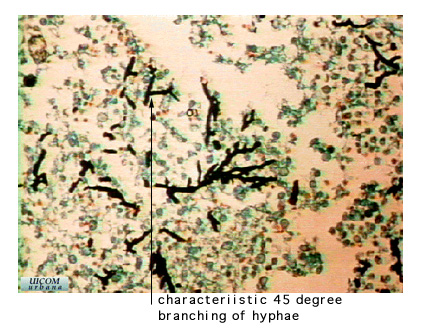
Allergic Fungal Sinusitis
Also as eosinophilic fungal rhinosinusitis, light microscopy of mucus sections. Histological sections of formalin fixed and paraffin embedded mucus, from patients suffering from allergic fungal sinusitis (eosinophilic fungal rhinosinusitis).
Kindly provided by Jens Ponikau, Mayo Clinic. Copyright Mayo Foundation 2003
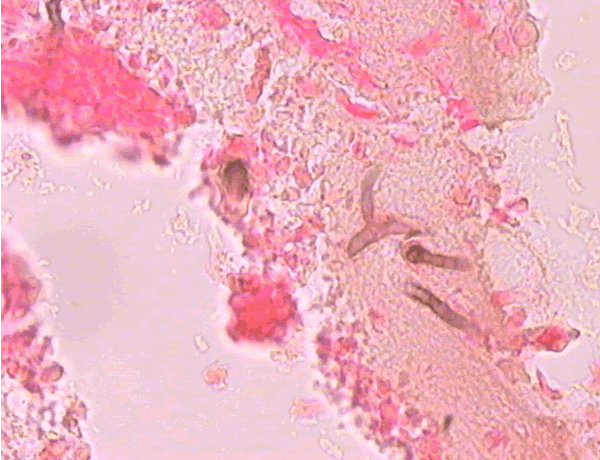
Calicifications in imaging. Allergic fungal sinusitis (AFS) is commonly caused by Aspergillus. Patients often have associated asthma. The MRI in addition to radiological abnormalities, thick pus or a clay-like substance was found in the sinuses. There was no allergic mucin, but dense hyphae are found. An inflammatory response in the mucosa was noted. Upon looking into the sinus, the fungus ball can vary in size from 1 mm or smaller to a size which completely occupies the sinus. It may have a greenish-black appearance.
Removal of the fungus ball is the typical treatment.
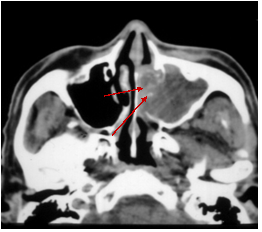
Corneal Ulcer - Gram Stain
Corneal scrapings were taken from a 67 yr old farmer presenting with a corneal ulcer of the right eye. A piece of vegetable matter was embedded in the cornea and scrapings were done. Gram stain (500x magnification) showed numerous septate hyphae. Cultures grew a small amount of A fumigatus
Kindly provided by Dr Ken Stottler (© Fungal Research Trust)
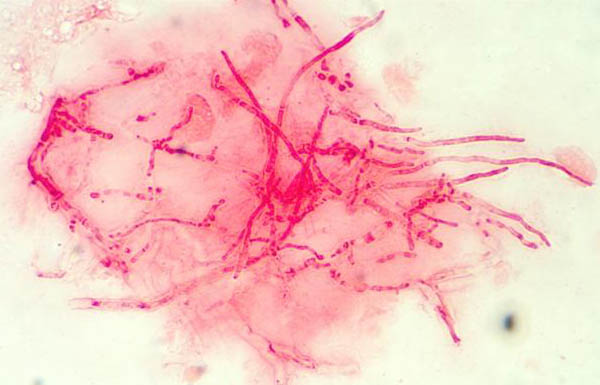
Lumbar Discitis
Macroscopic lesion of a lumbar intervertebral vertebral at autopsy, showing haemorrhagic necrosis, caused by hyphal invasion and infarction. The confirmation of genus and species was obtained by PCR on blood and vegetations; the discitis was a manifestation of disseminated aspergillosis.
Submitted by Dr R. Barnes and Dr C. Poynton, Cardiff.
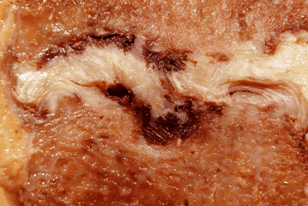
Hello:
I’m not necessarily supporting “Ted’s” outlined treatment plan; but, rather, I’m bringing to people’s attention that there maybe some validity in his findings.
Best of Health!
DD
http://www.earthclinic.com/CURES/alopecia.html
TEA TREE OIL AND LAVENDER OIL
7/31/2006: N writes, "For alopecia, tea tree oil and lavender oil should be used. However, they should only be used once a week. I used it daily and it burned my scalp."
Reader Questions:
2/3/2006: David from
2/5/2006: Ted, our Bankok,
The other recommendation to possibly cure your autoimmune disorder and at the same time encourage hair growth is to eat one cup of oatmeal everyday as it is high in silicon and I now have seen my immune system being restored upon taking silicon supplements I make for myself, which is primarily sodium metasilicate and silicic acid. Sometimes I also use sodium silicate. The usual dose for me is about 100 milligram -200 milligram. For you I will be more conservative and just say 50 milligram should do. Your hair, skin and nail should improve within 3-4 days and possible hair regrowth. Please apply EVERY OTHER DAY, pure aloe vera oil mixed with lavender and tea tree oil to allow regeneration of the scalp over the burned areas."
8/16/2005: Reader Question: "I don't have a scalp infection but do have Hair Loss Problem. How often and for how long should I use the tea tree oil & Lavender oil on my scalp? Also, I have an 18 year old friend who (since a little girl) has been combing her long thick hair back into a bun or pony tail. Her front hair has been gradually fallen off. Would the tea tree oil & lavender oil application work for her? If so how often & for how long should she use it? Thank you so much."
Ted responds, "Hair loss is usually due to vitamin C deficiency. You must take it everyday, between 250- 1000 mg. I would prefer sodium ascorbate. My own mother who is already 75 years old was suffering severe hair loss, and vitamin C simply solve the problems. However, a second cause of hair loss is fungus infection and you just use the tea tree/lavender for only once a week for a month and thats all. You don't need to do too much since the oils are quite strong anyway. These two remedies should solved most of the hair loss problem. In case it still don't work as well take some silcon supplements and/or vitamin D. They will improve the skin and the epidermis as well as hair growth.
Ted follows up: "First off, most fungus medications and shampoo do not work. The ones I recommended have been proven to work against fungus. It doesn't hurt to try and if it works fine. The second problem is whether it is a fungus problem. For one thing, hair growth problem is usually a sign of mineral imbalance usually the most common is mineral deficiency across the board. Get your hair mineral analysis done. The third factor, taking vitamin D and fulvic acid seems to really help with hair growth. You should see it within two weeks. The fourth factor is eating too much salted food seems to be a factor in preventing hair growth, this too and the drinking of softdrinks that contain aspartame seems destructive for hair growth due to relatively high formaldehyde from breakdown of aspartame which depresses the growth of hair follicles."
For humans the one tiny differences is that I would prefer you to use sodium perborate monohydrate (if you can find it), if not then saturated borax solution + H2O2 at 1% concentration after mixing, the apply to area in question, but do not rinse, and keep it overnight. Of course tea tree oil + lavender works in many cases too, however, you need to use it overnight also.
The same is true when you have Morgellon's disease (insects under your skin), which worked also. Unless if autoimmune is at issue, my findings were that autoimmune just don't happen because your body is attacking itself, I found quite often it is mycoplasma which just invade the cells, which is why I always recommend tea tree oil and lavender. Taking plenty of selenium supplements and garlic oil usually as an addition helps too. If hormonal imbalance is at issue, usually a simple way is just taking DHEA (I prefer a conservative 12.5 mg) plus some licorice extract, taken no longer than 1 week period. It is important to always take vitamin b complex as sometimes associated hair loss are deficiency related also. Ted
http://www.headlice.org/report/research/index.html
COLLEMBOLA (SPRINGTAILS) (ARTHROPODA: HEXAPODA:
ENTOGNATHA) FOUND IN SCRAPINGS FROM INDIVIDUALS
DIAGNOSED WITH DELUSORY PARASITOSIS
Deborah Z. Altschuler,a Michael Crutcher, MD, MPH, FACPM,b
Neculai Dulceanu, DVM, PhD (deceased),c Beth A. Cervantes,a
Cristina Terinte, MD, PhD,d and Louis N. Sorkin, BCEe
aNational Pediculosis Association, 50 Kearney Road, Needham, Massachusetts 02494;
bCommissioner of Health, Oklahoma State Department of Health,
1000 NE 10th Street, Oklahoma City, Oklahoma 73117;
cDepartment of Parasitology, University of Veterinary Medicine, Iasi, Romania;
dDepartment of Pathology, University of Medicine and Pharmacy, Iasi, Romania; and
eDivision of Invertebrate Zoology, American Museum of Natural History,
Abstract - Twenty individuals diagnosed with delusory parasitosis participated in a single site clinical study under the auspices of the National Pediculosis Association (NPA) and the Oklahoma State Department of Health. The objective of this study was to determine if there were any common factors in skin scrapings collected from this population. These individuals, whose symptoms were originally attributed to lice or scabies, were part of a larger group reporting symptoms of stinging/biting and/or crawling to the NPA. Multiple skin scrapings from each person were microscopically examined. Any and all fields of view that appeared incongruous to normal human skin were digitally photographed. When the photographic images were initially evaluated, no common factor was identified. However, more extensive scrutiny using imaging software revealed evidence of Collembola in 18 of the 20 participants.
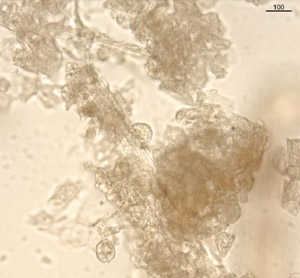
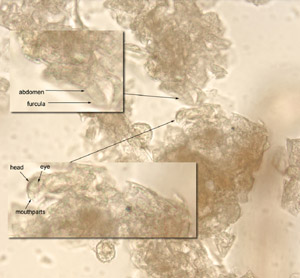

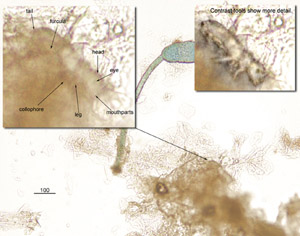

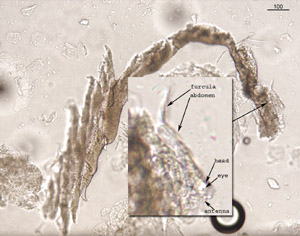
Malaria is on the rise because many drugs are no longer effective against the parasite that causes the disease. Not only is malaria found in tropical countries but the disease is spreading among North Americans and Europeans.
To find new treatments, scientists have to find safe doses of drugs that kill the parasite without harming humans. An antiseptic called triclosan appears to do the trick. It's used in household products like toothpaste and deodorants.
The researchers found triclosan blocks a bacterial enzyme called Fabl. Animals like humans use a very different set of enzymes, so triclosan does not harm us.
"This common, inexpensive antimicrobial is remarkably effective against these parasites," said first author Dr. Rima McLeod.
The University of Chicago researcher and her colleagues discovered triclosan interfered with the parasite's ability to make fatty acids and build its cellular membranes.
Preventing resistance
Triclosan was even effective against strains of the malaria parasite, Plasmodia falciparum, that were resistant to common anti-malaria drugs.
The researchers think triclosan could be combined with other enzyme blockers to punch more holes in the parasite's ability to make fatty acids. That way, the parasite will be less likely to become resistant to drugs in the future.
 |
04.23.2003 It's Enough To Make Your Skin Crawl: Microscopic Mites May Be Linked To Acne, Thinning Hair And Other Skin Disorders
|
| GAINESVILLE, Fla.--- You're not alone. Most people have thousands -- probably millions -- of tiny bugs called mites living in their hair and on their skin. And now a University of Florida researcher says the microscopic mites may be linked to thinning hair, acne and other skin conditions.
"Many people don't like the idea of bugs living in their hair or on their skin, and some get really bent out of shape just thinking about it," said Jerry Butler, a professor of entomology with UF's Institute of Food and Agricultural Sciences. "For some folks, it's enough to make your skin crawl. And bathing won't wash them off." Known as the Demodex mite, the bug lives in the hair follicles of 96 percent to 98 percent of all people and feeds on oils, hormones and fluids around the follicle. Butler has counted as many as 25 mites in a single hair follicle. In his UF entomology class, Butler lets students examine oily samples from their own skin pores to learn how well the mites are thriving on their bodies. For most people, the itty-bitty bugs are harmless and live in balance with their human host, he said. Most people and animals have a tolerance for the mites without developing any skin conditions, but high populations can cause problems. "When something causes the mites to reproduce at a higher rate, they can break out of the hair follicle and may cause acne, hair loss and other skin conditions," Butler said. "In some cases, the interaction with mites causes skin to actually slough off." He said studies have shown the mini-mite is associated with many kinds of skin conditions, but most researchers are reluctant to conclude it's a direct cause of those skin conditions. While Demodex may cause certain problems, it's also possible certain skin conditions become a breeding ground for mites. Dr. Frank Flowers, a professor of dermatology at UF's Health Science Center, said, "There is a tenuous link between Demodex, acne rosacea and folliculitis. However, no skin disease in humans has been conclusively linked with these mites." Flowers said that one of the most effective treatments for these disorders is metronidazole cream. Butler, a veterinary medical entomologist who has studied mites on dogs, said people probably react to large numbers of mites in the same way as our canine friends. "Based on my experience with dogs, particularly young animals whose hormone and immune systems are not fully developed, you probably get similar results on people," he said. "Populations can explode on dogs, causing mange-like symptoms. "The link between mites and hair loss and other skin conditions is not conclusive, but we do know it's a major problem for dogs," Butler said. "If you have high levels of hormones, you're going to have high levels of mite reproduction because these anthropods obtain their steroids from the host." Butler said Demodex poses the biggest threat to people under stress or those with cancer or other conditions such as HIV/AIDS that suppress the immune system. Mite colonies can spread unchecked because patients cannot produce the antibodies needed to control the parasites. "Under normal conditions, mites produce an antigen when they feed in a hair follicle, and then the human body makes antibodies against the bugs, thereby keeping their reproduction low and in balance," Butler said. "The mites are actually needed to make the antigen that stimulates the body into making protective antibodies." He said mites feed continuously inside the hair follicle. Three to five days are required for egg laying and hatching, followed by seven days for the larvae to develop into adults. Their total life span is probably several weeks. They're transferred from host to host by contact, particularly in hair, eyebrows and tiny sebaceous glands on the nose. If you suspect that mites could be a problem in your hair or on your skin, see a dermatologist promptly, Butler said.
|


















Add This Forum To Your Favorites!
Forum Stats:
forum viewed 3,404,703 times
3,922 messages
918 topics
topics per page limited to: 8
average number of messages per page: 34
114 pages
CureZone Newsletter is distributed in partnership with www.netatlantic.com
Copyright 1999 - 2024 www.curezone.org